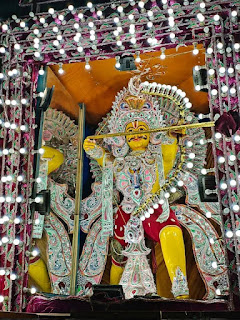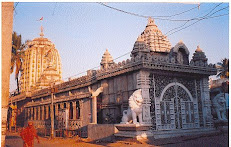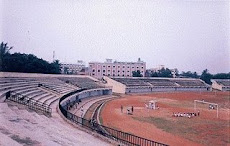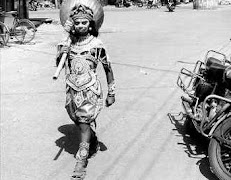Monday, June 9, 2025
ଲୋକଙ୍କ ସରକାରରେ ବିକଶିତ ହେଉଛି ଓଡ଼ିଶା। ଶିଳ୍ପ ଓ ଭିତ୍ତିଭୂମିର ବିକାଶ ସହ ନିଯୁକ୍ତି ଓ ରୋଜଗାରର ବାଟ ଫିଟୁଛି।
 Author, Researcher, Activist & Associate Editor- New Delhi.
Authored & Co-Authored several Books on History, Culture and Society for various Universities,
Associated with Odisha Development Forum as its President & working for the development of the Tribal dominated backward Districts of Odisha.
Author, Researcher, Activist & Associate Editor- New Delhi.
Authored & Co-Authored several Books on History, Culture and Society for various Universities,
Associated with Odisha Development Forum as its President & working for the development of the Tribal dominated backward Districts of Odisha.
Tuesday, April 29, 2025
Kalakunja During the Famous Brahmapur Thakurani Jatra
 Author, Researcher, Activist & Associate Editor- New Delhi.
Authored & Co-Authored several Books on History, Culture and Society for various Universities,
Associated with Odisha Development Forum as its President & working for the development of the Tribal dominated backward Districts of Odisha.
Author, Researcher, Activist & Associate Editor- New Delhi.
Authored & Co-Authored several Books on History, Culture and Society for various Universities,
Associated with Odisha Development Forum as its President & working for the development of the Tribal dominated backward Districts of Odisha.
Tuesday, November 12, 2024
Odisha Works Minister Harichandan Reviews Berhampur-Jeypore Green Field High-Speed Corridor
A review meeting, chaired by Law, Works, and Excise Minister Prithviraj Harichandan, discussed the proposed Berhampur-Jeypore High-Speed Corridor and Green Field Project on 7 November 2024. This project aims to reduce travel time from Berhampur to Jeypore from seven hours to just three hours, with vehicles reaching speeds of up to 120 kmph.
The proposed corridor will have tunnels at four places to prevent accidents on hilly-terrain roads. Minister Harichandan emphasized the importance of improving connectivity between major cities, mining areas, and industrial zones along this high-speed corridor, while also ensuring that the project does not harm biodiversity areas.
To achieve this, officials have been advised to prepare a plan that prioritizes environmental conservation. The Minister also stressed the need for efficient land acquisition and forest land settlement to make the proposed corridor more acceptable to the public.
Key officials present at the meeting included Principal Secretary V. V. Yadav, Special Secretary Deepak Das, Chief Engineer (Civil) Purnachandra Mahapatra, OBCC Joint Adviser Jay Krushna Das, and SPARC Managing Director Shubdarshi Mishra.
 Author, Researcher, Activist & Associate Editor- New Delhi.
Authored & Co-Authored several Books on History, Culture and Society for various Universities,
Associated with Odisha Development Forum as its President & working for the development of the Tribal dominated backward Districts of Odisha.
Author, Researcher, Activist & Associate Editor- New Delhi.
Authored & Co-Authored several Books on History, Culture and Society for various Universities,
Associated with Odisha Development Forum as its President & working for the development of the Tribal dominated backward Districts of Odisha.
Monday, October 21, 2024
୧୯୯୯ ଅକ୍ଟୋବର ମହାବାତ୍ୟା। ଭୁଲିନି ଗଞ୍ଜାମ...
ମନେପଡ଼େ ମହାବାତ୍ୟା, ଅକ୍ଟୋବର କାଳ ରାତିକୁ ଭୁଲିନି ଗଞ୍ଜାମ, ରାତି ୯ରୁ ବଢ଼ିଥିଲା ପବନ ବେଗ...
୨୫ ବର୍ଷ ତଳେ ଗଞ୍ଜାମବାସୀ ଦେଖିଥିଲେ ପ୍ରକୃତିର କରାଳ ରୂପ । ୧୯୯୯ ଅକ୍ଟୋବର ମହାବାତ୍ୟାରେ ଲିଭି ଯାଇଥିଲା ୧୮୩ । କେତେ ଭୟାନକ ଥିଲା ୧୮ ତାରିଖ କାଳ ରାତି ?
ବ୍ରହ୍ମପୁର: 1999 ମସିହା ଅକ୍ଟୋବର 29 ତାରିଖ ମହାବାତ୍ୟାକୁ ଓଡି଼ଶାବାସୀ କେବେବି ଭୁଲି ପାରିବେନି । କିନ୍ତୁ ଏହା ପୂର୍ବରୁ ଅକ୍ଟୋବର 18 ତାରିଖରେ ଗଞ୍ଜାମ ଜିଲ୍ଲାରେ ତାଣ୍ଡବ ରଚିଥିଲା ବାତ୍ୟା। ବାତ୍ୟାର ଆଶଙ୍କା ରହିଥିବା ନେଇ ମିଳିଥିଲା ସୂଚନା । ଆଉ ଏହାପରେ
ଗଞ୍ଜାମ ଉପକୂଳରେ ଆରମ୍ଭ ହୋଇଯାଇଥିଲା ତୁହାକୁ ତୁହା ବର୍ଷା ସାଙ୍ଗକୁ ପବନ । ଆଉ ତା ପରେ ଯାହା ହୋଇଥିଲା, କେବଳ ନିକଟରୁ ଦେଖିଥିବା ଲୋକେ ହିଁ କହିପାରିବେ ?
୧୯୯୯ ବାତ୍ୟା ଓ ଗୋପାଳପୁର:
ଗଞ୍ଜାମ ଜିଲ୍ଲା ବ୍ରହ୍ମପୁର ନିକଟ ଗୋପାଳପୁର ବେଳାଭୂମି । ୧୯୯୯ ଅକ୍ଟୋବର ୧୮ରେ ଏହାର ସ୍ଥଳଭଗକୁ ସ୍ପର୍ଶ କରି ତାଣ୍ଡବ ରଚିଥିଲା ବାତ୍ୟା । ରାତି ପାହିଲା ବେଳକୁ ସବୁ କିଛି ଛାରଖାର ହୋଇ ଯାଇଥିଲା । ମାଟିରେ ମିଶିଥିଲା ସହ ସହ ଘର, କେଇ ମୁହୂର୍ତ୍ତରେ ଚାଲିଯାଇଥିଲା ଶତାଧିକ ଜୀବନ । ସେହି ମହାବାତ୍ୟାକୁ ଆଜି 25 ବର୍ଷ ପୂରିଛି, ପ୍ରକୃତିର ସେ ତାଣ୍ଡବ ମନେ ପଡିଲେ ଆଜିବି ଗଞ୍ଜାମବାସୀଙ୍କ ଛାତି ଥରି ଉଠୁଛି, ଟାଙ୍କୁରି ଉଠୁଛି ଲୋମ ।
ମନେପଡ଼େ ମହାବାତ୍ୟା, ଅକ୍ଟୋବର କାଳ ରାତିକୁ ଭୁଲିନି ଗଞ୍ଜାମ, ରାତି ୯ରୁ ବଢ଼ିଥିଲା ପବନ ବେଗ...
୨୫ ବର୍ଷ ତଳେ ଗଞ୍ଜାମବାସୀ ଦେଖିଥିଲେ ପ୍ରକୃତିର କରାଳ ରୂପ । ୧୯୯୯ ଅକ୍ଟୋବର ମହାବାତ୍ୟାରେ ଲିଭି ଯାଇଥିଲା ୧୮୩ । କେତେ ଭୟାନକ ଥିଲା ୧୮ ତାରିଖ କାଳ ରାତି
ମହାବାତ୍ୟାକୁ ୨୫ ବର୍ଷ, ଯାଇଥିଲା ୧୮୩ ଜୀବନ
1999 ମସିହାର ଅକ୍ଟୋବର ମାସ 18 ତାରିଖ । ଗଞ୍ଜାମ ଉପକୂଳରେ ସେ ଦିନର ଅପରାହ୍ନରୁ ହିଁ ଆରମ୍ଭ ହୋଇଥିଲା ପବନ ସାଙ୍ଗକୁ ତୁହାକୁ ତୁହା ବର୍ଷା । ସମୟ ବଢିବା ସହିତ ବାତ୍ୟାର ପ୍ରଭାବ ବୃଦ୍ଧି ପାଇଥିଲା । ସେହି ସମୟର ସାଟେଲାଇଟ୍ ଫୋନ୍ ରୁ ଖବର ମିଳିବା ପରେ ସମୁଦ୍ର କୂଳିଆ ଅଞ୍ଚଳରେ ରହୁଥିବା ଜନସାଧାରଣଙ୍କୁ ଖବର ଦିଆଯାଇଥିଲା । ହେଲେ ଏହାର କିଛି ଘଣ୍ଟା ମଧ୍ୟରେ ବାତ୍ୟାର କରାଳ ରୂପ ଧାରଣ କରି ସବୁକିଛି ନିମିଶକେ ମଧ୍ୟରେ ଛାରଖାର କରି ଦେଇଥିଲା । ରାତି ପାହିବା ବେଳେକୁ ମାଟିରେ ମିଶିିଥିଲା ଶହ ଶହ ଘର, ସମ୍ପର୍କୀୟଙ୍କୁ ହରାଇ କାନ୍ଦ ବୋବାଳିରେ ଫାଟି ପଡୁଥିଲା ଚତୁର୍ଦିଗ । ଜିଲ୍ଲାରୁ କେବଳ ୧୮୩ ଜଣଙ୍କ ଜୀବନ ଯାଇଥିବା ସରକାରୀ ତଥ୍ୟରୁ ଜଣାପଡେ ।
ମନରୁ ଲିଭିନି ମହାବାତ୍ୟା କରାଳ ରୂପ :
ବାତ୍ୟା ପ୍ରଭାବରେ ସମୁଦ୍ର କୂଳବର୍ତ୍ତୀ ଅଞ୍ଚଳରେ ରହିଥିବା ଅନେକ କଚା ଘର ବହୁ ମାତ୍ରରେ କ୍ଷତିଗ୍ରସ୍ତ ହୋଇଥିଲା । ସମୁଦ୍ରରେ ମାଛ ଧରି ଜୀବିକା ନିର୍ବାହ କରି ଆସୁଥିବା ମତ୍ସଜୀବୀ ପରିବାରଙ୍କ ଠାରୁ ଆରମ୍ଭ କରି ଗରୀବ ପରିବାରର ବ୍ୟକ୍ତିବିଶେଷ ମାନେ ଅନେକ ମାତ୍ରାରେ କ୍ଷତିଗ୍ରସ୍ତ ହୋଇଥିଲେ । ଆଉ ସେହି ବାତ୍ୟା ଓଡିଶାର ମହାବାତ୍ୟା ଭାବରେ ପରିଚିତ ରହିଥିବା ବେଳେ ଏବେବି ଉକ୍ତ ଘଟଣାକୁ କ୍ୟାମେରା ସାମ୍ନାରେ ବଖାଣିଛନ୍ତି ସମୁଦ୍ର କୂଳରେ ରହୁଥିବା ମତ୍ସ୍ୟଜୀବୀ ।
ବାତ୍ୟାରୁ କଣ ଶିକ୍ଷା ପାଇଲା ଗଞ୍ଜାମ:
ମହାବାତ୍ୟା ପରେ ଗଞ୍ଜାମ ଜିଲ୍ଲାବାସୀ ଅନେକ କିଛି ଶିକ୍ଷାଲାଭ କରିଥିଲେ । ପରବର୍ତ୍ତୀ ସମୟରେ ସମୁଦ୍ରକୂଳବର୍ତ୍ତୀ ଅଞ୍ଚଳରେ ରହୁଥିବା ବ୍ୟକ୍ତି ବିଶେଷ ମାନେ ବାତ୍ୟା ଓ ବନ୍ୟାକୁ କିପରି ମୁକାବିଲା କରିବେ ତାହାକୁ ନେଇ ଦିଆଯାଇଥିଲା ଅଧିକ ଗୁରୁତ୍ୱ । ପ୍ରତ୍ୟେକ ଗ୍ରାମ ଏବଂ ପଞ୍ଚାୟତ ସ୍ତରରେ ବିଭିନ୍ନ ପ୍ରକାର କମିଟି କରାଯାଇ ନିୟମିତ ବ୍ୟବଧାନରେ ତାଲିମ ଏବଂ ଅଭ୍ୟାସ ଆରମ୍ଭ ହୋଇଥିଲା । ପୂର୍ବରୁ ବାତ୍ୟାର ପ୍ରଭାବ କିପରି ରହିବ ସେନେଇ ଯଥା ସମୟ ପୂର୍ବରୁ ସୂଚନା ପହଞ୍ଚିନଥିବା ଯୋଗୁଁ ବହୁ ମାତ୍ରାରେ କ୍ଷୟକ୍ଷତି ହୋଇଥାଏ । ପରବର୍ତ୍ତୀ ସମୟରେ ଆଧୁନିକ ଜ୍ଞାନକୌଶଳର ବ୍ୟବହାର କରାଯାଇ ଆଧୁନିକରଣ ବ୍ୟବସ୍ଥା ମାଧ୍ୟମରେ ତୁରନ୍ତ ସୂଚନା ପହଞ୍ଚିବାଠାରୁ ଆରମ୍ଭ କରି ଲୋକଙ୍କୁ ସୁରକ୍ଷିତ ଭାବରେ ଉଦ୍ଧାର କରାଯାଇ ଆଶ୍ରୟସ୍ଥଳରେ ପହଞ୍ଚାଇବା ଭଳି କାର୍ଯ୍ୟ କରାଯାଉଛି ।
ସମ୍ଭାବ୍ୟ ବାତ୍ୟାକୁ ନେଇ କେତେ ପ୍ରସ୍ତୁତ ଗଞ୍ଜାମ ?
ମହାବାତ୍ୟା ପରେ ବ୍ୟାପକ ସଚେତନତା ସହିତ ସଧାରଣ ଜନତାଙ୍କ ଭାଗୀଦାର ଏବଂ ସହଯୋଗ ଯୋଗୁଁ ଗଞ୍ଜାମ ଉପକୂଳରେ ତାର ପରବର୍ତ୍ତୀ ସମୟରେ ଦେଖାଯାଇଥିବା କେତେକ ବାତ୍ୟାର ଜିଲ୍ଲା ପ୍ରଶାସନ ସଠିକ ମୁକାବିଲା କରିଥିଲା । 2013 ମସିହାର ଫାଇଲିନର ବାତ୍ୟାରେ 20 ଜଣଙ୍କର ମୃତ୍ୟୁ ହୋଇଥିବା ବେଳେ, 2018ମସିହାର ତିତିଲି ବାତ୍ୟା 15 ଜଣଙ୍କର ମୃତ୍ୟୁ ହୋଇଥିଲା । ଗତ କିଛି ବର୍ଷ ଧରି ଏଭଳି ପ୍ରାକୃତିକ ବିପର୍ଯ୍ୟୟ ସମୟରେ ରାଜ୍ୟରେ ଜିରୋ କାଜୁଆଲିଟି ଉପରେ ଅଧିକ ଗୁରୁତ୍ୱ ଦିଆଯାଉଛି । ସେହିପରି ଜିଲ୍ଲାରେ ଅଦ୍ୟାବଧି 78 ଗୋଟି ବହୁମୁଖୀ ବାତ୍ୟା ଆଶ୍ରୟସ୍ଥଳୀ ଏବଂ 32 ଗୋଟି ବହୁମୁଖୂ ବନ୍ୟା ଆଶ୍ରୟସ୍ଥଳ ରହିଛି । ବିପର୍ଯ୍ୟୟର ମୁକାବିଲା କିପରି କରିହେବ ସେନେଇ ଜିଲ୍ଲା ପ୍ରଶାସନ, ବ୍ଲକ ପ୍ରଶାସନ ପକ୍ଷରୁ ବ୍ୟାପକ ପଦକ୍ଷେପ ଗ୍ରହଣ କରାଯାଇଛି ।
2013ରେ ଫାଇଲିନ ବାତ୍ୟାରେ ୨୦ ଜଣ ମୃତ୍ୟୁ
2018ରେ ତିତିଲି ବାତ୍ୟାରେ ଯାଇଥିଲା ୧୫ ଜୀବନ
ଗଞ୍ଜାମ ଜିଲ୍ଲାରେ ୭୮ ବହୁମୁଖୀ ବାତ୍ୟା ଆଶ୍ରୟସ୍ଥଳୀ
୩୨ ବହୁମୁଖୀ ବନ୍ୟା ଆଶ୍ରୟସ୍ଥଳୀ ରହିଛି
ଗଞ୍ଜାମ ଜିଲ୍ଲାପାଳ ଦିବ୍ୟଜ୍ୟୋତି ପରିଡା ଏନେଇ କହିଛନ୍ତି, ''ବାତ୍ୟାକୁ ନେଇ ବିଭିନ୍ନ ସ୍ଥରରେ ଆମର ପ୍ରସ୍ତୁତି ଜାରି ରହିଛି । ଡିଜାଷ୍ଟର ମ୍ୟାନେଜମେଣ୍ଟ, ରେସପନସ ଟିମ ପୂରା ପ୍ରସ୍ତୁତ । ବିଭିନ୍ନ ସ୍ତରରେ ବାତ୍ୟା ମୁକାବିଲା ପାଇଁ ଅଭ୍ୟାସ ଜାରି ରହିଛି । ସବୁ ସ୍ଥାନରେ ଉପଯୁକ୍ତ ବ୍ୟବସ୍ଥା ଅଛି ନା ନାହିଁ ତାହା ଯାଞ୍ଚ କରାଯାଉଛି । ''
1999 ମସିହା ମହାବାତ୍ୟା:
1999 ମସିହାର ସେହି ମହାବାତ୍ୟାରେ ପ୍ରଥମେ ଅକ୍ଟୋବର 18 ତାରିଖରେ ଗଞ୍ଜାମ ଜିଲ୍ଲାର ଗୋପାଳପୁର ସମେତ ଅନେକ ଅଞ୍ଚଳ କ୍ଷତିଗ୍ରସ୍ତ ହୋଇଥିଲା । ଏହାପରେ ଅକ୍ଟୋବର 29 ତାରିଖରେ ଜଗତସିଂହପୁର ଜିଲ୍ଲା ପାରାଦ୍ୱୀପ ଉପକୂୂଳରେ ଦେଖାଦେଇଥିବା ମହାବାତ୍ୟାରେ ପ୍ରାୟ 10 ହଜାର ଲୋକଙ୍କ ଜୀବନ ଯାଇଥିଲା ।By ETV Bharat Odisha Team
Published : Oct 18, 2024, 2:39 PM IST
ଇଟିଭି ଭାରତ, ବ୍ରହ୍ମପୁର
 Author, Researcher, Activist & Associate Editor- New Delhi.
Authored & Co-Authored several Books on History, Culture and Society for various Universities,
Associated with Odisha Development Forum as its President & working for the development of the Tribal dominated backward Districts of Odisha.
Author, Researcher, Activist & Associate Editor- New Delhi.
Authored & Co-Authored several Books on History, Culture and Society for various Universities,
Associated with Odisha Development Forum as its President & working for the development of the Tribal dominated backward Districts of Odisha.
Thursday, May 30, 2024
କାମ୍ବୋଡିଆର ବିଖ୍ୟାତ ଆଙ୍ଗକର ଭଟ୍ଟ ମନ୍ଦିର
*କାମ୍ବୋଡିଆର ବିଖ୍ୟାତ ଆଙ୍ଗକର ଭଟ୍ଟ ମନ୍ଦିର*
 Author, Researcher, Activist & Associate Editor- New Delhi.
Authored & Co-Authored several Books on History, Culture and Society for various Universities,
Associated with Odisha Development Forum as its President & working for the development of the Tribal dominated backward Districts of Odisha.
Author, Researcher, Activist & Associate Editor- New Delhi.
Authored & Co-Authored several Books on History, Culture and Society for various Universities,
Associated with Odisha Development Forum as its President & working for the development of the Tribal dominated backward Districts of Odisha.
Thursday, May 23, 2024
In India, a Missing Key to a Temple’s Treasure Vault Ignites a Furor
Source: The New York Times
Operation Hidden Idol, as the investigation involving Mr. Kapoor was called, found that some of the items, such as a thousand-year-old bronze statue of the elephant-headed Ganesha, ended up at the world’s leading museums including the Metropolitan Museum of Art. Mr. Kapoor is facing trial in India.
But the hive-shaped Jagannath Temple in Puri, which forms part of the pilgrimage known as Char Dham — a four-part circuit traveled by Hindus to attain salvation — is far from an easy target.
A tight-lipped committee controls who can enter, where donations of money or jewelry are stored and how that information is disseminated to the public. The strict entry rules are designed to safeguard both the temple’s status as a sacred space and the treasures it contains.
In 1984, Indira Gandhi, then prime minister, was famously denied entry because her husband was a follower of Zoroastrianism, an ancient monotheistic religion. Even today, priests guard the entrance, turning away non-Hindus and some non-Indians from sects such as Hare Krishna, which is popular in the West.
An internal temple report from 1978 explained the policy — unusual for temples in India — with an analogy: “If the petals of a beautiful rose are torn and dissected for the purpose of investigating the ingredients of its color and smell, then the rose no longer remains a rose. It becomes a rubbish to be thrown away.”
In the 1930s, Mahatma Gandhi, the leader of India’s independence movement, refused to enter the temple in protest against its entry restrictions, according to Ramachandra Guha, an Indian historian. The temple eventually opened its doors to some Hindus who had been barred previously, including Dalits, a lower caste. But the insular mind-set remained.
This year, the temple made headlines when India’s Supreme Court suggested changing the rule preventing non-Hindus from entering. But many recommendations were abandoned.
“There’s a very long history of absolute reactionist bigotry,” Mr. Guha said of the temple’s exclusionary policies.
Reports of internal strife have also tarnished the temple’s reputation over past decades. Managers of the temple said in the 1978 report that “misappropriation, theft, lawlessness, harassment of pilgrims and exploitation had become the order of the day.”
That same year, to encourage transparency, an inventory was made of the vault. Temple officials reported finding a hoard of nearly 500 pounds of antique silver and gold ornamental jewelry designed to adorn statues of gods.
The vault was last opened in 1985, according to R. N. Mishra, a former temple administrator, who said that he and a group of officials had retrieved some gold for maintenance work and promptly returned the key to the district treasury.
After the furor this year over the loss of the key, temple caretakers said they had found a duplicate in the record room of the local magistrate’s office. Instead of quelling anger, the apparent discovery inspired more questions: When was the duplicate key made? Was it real? And where was the original?
Mr. Mishra called the loss of the original key a “gross negligence,” saying that a duplicate had not existed when he was administrator and that he was not aware of one ever having been made. “One key, one lock,” he said.
Dibyasingha Deb, a member of Puri’s royal family and the chairman of the temple’s managing committee, said that accusations of mismanagement were unfair. He shifted blame to outsiders trying to “make us a laughingstock.”
“When people write about these incidents, and they don’t have any faith in our religion, our culture, they would like to make it a very sarcastic sort of a way of projecting things,” he said in an interview.
But Pitambar Acharya, a lawyer in the Orissa High Court, the highest one in Odisha State, said he felt that temple caretakers were bluffing on what he called the “key loss hullabaloo.”
Last month, Mr. Acharya and other officials from the Bharatiya Janata Party, an opposition party in Odisha, lodged a complaint with the police against top state officials in charge of tracking temple valuables, citing their failure to inventory jewelry in the vault regularly and questioning whether a duplicate key even existed.
“There has been a clear breach of trust,” he said, relating to unanswered questions on the loss of the temple key and the supposed discovery of a duplicate.
Outside the temple, in a packed plaza where men hammered together wooden chariots to be used for a festival, anger was palpable among priests, shop owners and visitors.
“The government is hiding facts,” said Satyavaan Sahu, 31, a worker at a nearby trinket shop. “It is a disrespect. Everybody’s faith in the temple will go away.”
As the sun set in Puri, a throng of devotees climbed the temple’s broad, stone steps, where a man ushered them in by tapping their heads with two slender sticks, a transfer of the deity’s blessings.
Inside the temple, priests squatted to light oil lamps. Flanked by pillars covered in brightly colored motifs, thousands of men and women threw up their hands at the sight of a life-size statue of Lord Jagannath. Nearby, the entrance to the vault was shrouded in darkness behind metal bars.
Sonalata Das, 67, a bespectacled woman in a brown silk sari, lingered with clasped hands in front of a painting of Lord Jagannath. Asked about the missing keys, her face hardened.
“I prayed that God would completely finish off the person who has fooled around with the key for his wealth,” she said. “May he be destroyed.”
Follow Kai Schultz and Suhasini Raj on Twitter: @Kai_Schultz and @suhasiniraj.
To Read The Article Click here: https://www.nytimes.com/2018/07/14/world/asia/india-jagannath-temple-key-gold.html
 Author, Researcher, Activist & Associate Editor- New Delhi.
Authored & Co-Authored several Books on History, Culture and Society for various Universities,
Associated with Odisha Development Forum as its President & working for the development of the Tribal dominated backward Districts of Odisha.
Author, Researcher, Activist & Associate Editor- New Delhi.
Authored & Co-Authored several Books on History, Culture and Society for various Universities,
Associated with Odisha Development Forum as its President & working for the development of the Tribal dominated backward Districts of Odisha.













































.jpg)

















































